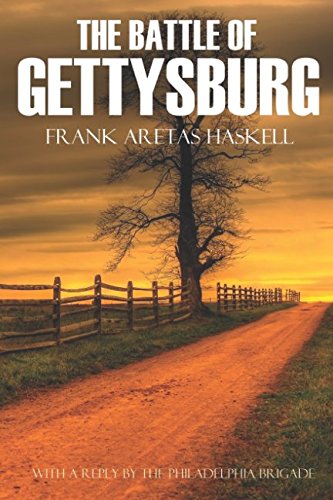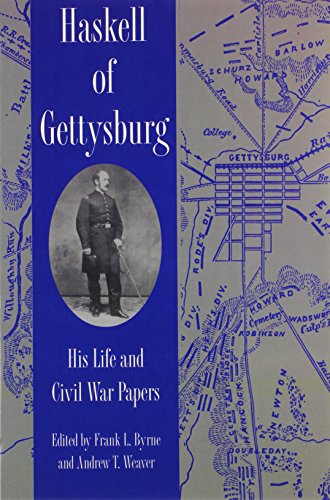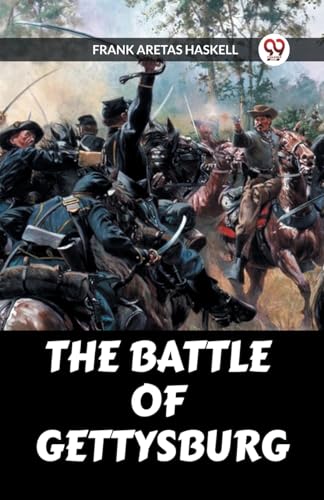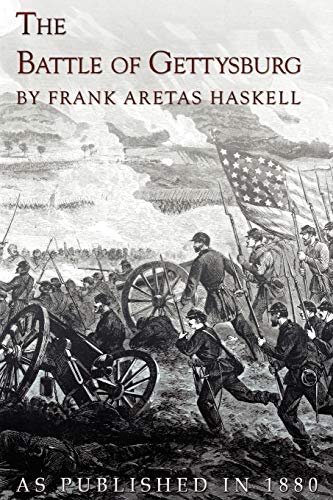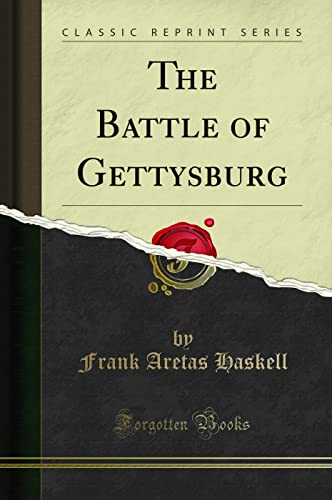Aretas Haskell Frank (128 results)
Search filters
Product Type
- All Product Types
- Books (128)
- Magazines & Periodicals (No further results match this refinement)
- Comics (No further results match this refinement)
- Sheet Music (No further results match this refinement)
- Art, Prints & Posters (No further results match this refinement)
- Photographs (No further results match this refinement)
- Maps (No further results match this refinement)
- Manuscripts & Paper Collectibles (No further results match this refinement)
Condition Learn more
Binding
Collectible Attributes
- First Edition (6)
- Signed (No further results match this refinement)
- Dust Jacket (5)
- Seller-Supplied Images (46)
- Not Print on Demand (84)
Language (2)
Free Shipping
Seller Location
Seller Rating
-
The Battle of Gettysburg (Expanded, Annotated)
Published by Independently published, 2016
ISBN 10: 1519049668 ISBN 13: 9781519049667
Language: English
Seller: Greenworld Books, Arlington, TX, U.S.A.
Condition: good. Fast Free Shipping â" Good condition book with a firm cover and clean, readable pages. Shows normal use, including some light wear or limited notes highlighting, yet remains a dependable copy overall. Supplemental items like CDs or access codes may not be included.
-
The Battle of Gettysburg (Expanded, Annotated)
Published by Independently published, 2016
ISBN 10: 1519049668 ISBN 13: 9781519049667
Language: English
Seller: More Than Words, Waltham, MA, U.S.A.
Condition: Good. . . All orders guaranteed and ship within 24 hours. Before placing your order for please contact us for confirmation on the book's binding. Check out our other listings to add to your order for discounted shipping.
-
The Battle of Gettysburg (Expanded, Annotated)
Published by Independently published, 2016
ISBN 10: 1519049668 ISBN 13: 9781519049667
Language: English
Seller: HPB-Red, Dallas, TX, U.S.A.
paperback. Condition: Good. Connecting readers with great books since 1972! Used textbooks may not include companion materials such as access codes, etc. May have some wear or writing/highlighting. We ship orders daily and Customer Service is our top priority!
-
Haskell of Gettysburg: His Life and Civil War Papers
Published by Kent State University Press, 1989
ISBN 10: 0873383869 ISBN 13: 9780873383868
Language: English
Seller: ThriftBooks-Dallas, Dallas, TX, U.S.A.
Paperback. Condition: Very Good. No Jacket. May have limited writing in cover pages. Pages are unmarked. ~ ThriftBooks: Read More, Spend Less 1.
-
Haskell of Gettysburg: His Life and Civil War Papers
Published by Kent State University Press, 1989
ISBN 10: 0873383869 ISBN 13: 9780873383868
Language: English
Seller: ThriftBooks-Atlanta, AUSTELL, GA, U.S.A.
Paperback. Condition: Fair. No Jacket. Readable copy. Pages may have considerable notes/highlighting. ~ ThriftBooks: Read More, Spend Less.
-
Haskell of Gettysburg: His Life and Civil War Papers
Published by Kent State University Press, 1989
ISBN 10: 0873383869 ISBN 13: 9780873383868
Language: English
Seller: ThriftBooks-Atlanta, AUSTELL, GA, U.S.A.
Paperback. Condition: Very Good. No Jacket. May have limited writing in cover pages. Pages are unmarked. ~ ThriftBooks: Read More, Spend Less.
-
Haskell of Gettysburg: His Life and Civil War Papers
Published by Kent State University Press, 1989
ISBN 10: 0873383869 ISBN 13: 9780873383868
Language: English
Seller: ThriftBooks-Atlanta, AUSTELL, GA, U.S.A.
Paperback. Condition: Good. No Jacket. Pages can have notes/highlighting. Spine may show signs of wear. ~ ThriftBooks: Read More, Spend Less 1.
-
Haskell of Gettysburg: His Life and Civil War Papers
Published by Kent State University Press, 1989
ISBN 10: 0873383869 ISBN 13: 9780873383868
Language: English
Seller: ThriftBooks-Dallas, Dallas, TX, U.S.A.
Paperback. Condition: Good. No Jacket. Pages can have notes/highlighting. Spine may show signs of wear. ~ ThriftBooks: Read More, Spend Less 1.
-
Condition: New. LATEST EDITION NO-PA16APR2015-KAP.
-
Condition: New.
-
Condition: New.
-
The Battle of Gettysburg (Paperback or Softback)
Published by Double 9 Books 1/1/2024, 2024
ISBN 10: 9360465275 ISBN 13: 9789360465278
Language: English
Seller: BargainBookStores, Grand Rapids, MI, U.S.A.
Paperback or Softback. Condition: New. The Battle of Gettysburg. Book.
-
The Battle of Gettysburg (Paperback or Softback)
Published by Digital Scanning 1/1/2002, 2002
ISBN 10: 1582187223 ISBN 13: 9781582187228
Language: English
Seller: BargainBookStores, Grand Rapids, MI, U.S.A.
Paperback or Softback. Condition: New. The Battle of Gettysburg. Book.
-
Condition: As New. Unread book in perfect condition.
-
Condition: New.
-
Condition: New.
-
Condition: New.
-
Condition: New.
-
PAP. Condition: New. New Book. Shipped from UK. Established seller since 2000.
-
The Battle of Gettysburg
Published by Double 9 Books LLP, IN, 2024
ISBN 10: 9360465275 ISBN 13: 9789360465278
Language: English
Seller: Rarewaves.com USA, London, LONDO, United Kingdom
Paperback. Condition: New.
-
Paperback. Condition: new. Paperback. Frank Aretas Haskell historical tale "The Battle of Gettysburg" gives a firsthand account of one of the most important battles of the American Civil War. As a player within the Battle of Gettysburg, Haskell gives an intimate and thorough account of the occasions that came about in the course of this pivotal battle. The tale starts off evolved with the Union army's arrival in Gettysburg and the combating that followed with the Confederate navy. Haskell paints a bright photograph of the fierce combat, the tactical choices made through leaders, and the general mayhem at the battlefield. He captures the human fee and the bravery of soldiers on both aspects, providing insight into the difficulties faced through both Union and Confederate armies. Haskell's testimony explores the psychological and emotional facets of combating in addition to being a tactical memory. He considers the comradery the various troops, the sufferings they went via, and the conflict's lasting results on the country. Frank Aretas Haskell's "The Battle of Gettysburg" is a useful historical account that gives readers with an up-near observe the events that befell at some stage in this momentous struggle. Shipping may be from multiple locations in the US or from the UK, depending on stock availability.
-
The Battle of Gettysburg
Published by Double 9 Books LLP, IN, 2024
ISBN 10: 9360465275 ISBN 13: 9789360465278
Language: English
Seller: Rarewaves USA, OSWEGO, IL, U.S.A.
Paperback. Condition: New.
-
PAP. Condition: New. New Book. Shipped from UK. Established seller since 2000.
-
PAP. Condition: New. New Book. Shipped from UK. Established seller since 2000.
-
The Battle of Gettysburg
Published by Literary Licensing, LLC, 2014
ISBN 10: 1497985048 ISBN 13: 9781497985049
Language: English
Seller: ThriftBooks-Atlanta, AUSTELL, GA, U.S.A.
Paperback. Condition: Good. No Jacket. Missing dust jacket; Pages can have notes/highlighting. Spine may show signs of wear. ~ ThriftBooks: Read More, Spend Less 0.64.
-
Condition: new.
-
The Battle of Gettysburg
Published by Wisconsin Historical Commission, Madison WI, 1910
Seller: Chequamegon Books, Washburn, WI, U.S.A.
Hardcover. Condition: good. Second Edition. This is Wisconsin History Commission reprints No. 1. 192 pages. This is the second edition, limited to 2500 copies; 6 1/4 x 9 1/8 " Ex college library copy. spine labels inked out, library bookplate on inside front cover. previous (to library) owner's name on first page dated 1931 white tape applied to inside front and rear hinges. pocket and sticker on inside rear cover. some rubbing and handling to covers. a good reading/reference copy.
-
Paperback. Condition: Brand New. 86 pages. 5.50x0.21x8.50 inches. In Stock.
-
The Battle of Gettysburg (Wisconsin History Commission Reprints, No. 1)
Published by Wisconsin History Commission
Condition: Fair. . Wisconsin History Commission Reprints, No. 1. Limited edition of 2500 copies. Reading copy only. Front hinge cracked. Rear hinge split. Owner's name on front pastedown. (Civil War, Battles, Pennsylvania, Military History).
-
HRD. Condition: New. New Book. Shipped from UK. Established seller since 2000.



